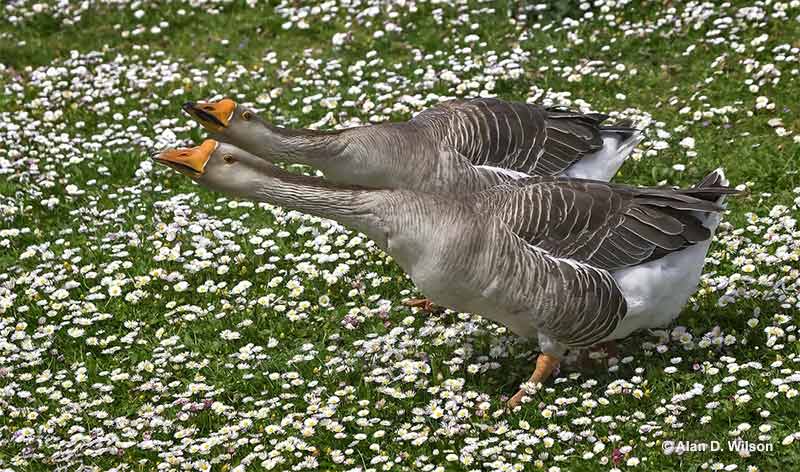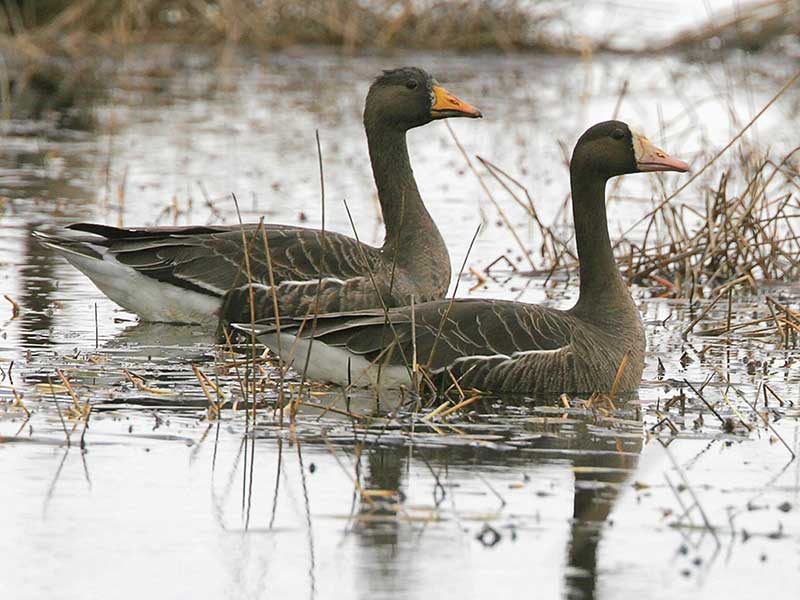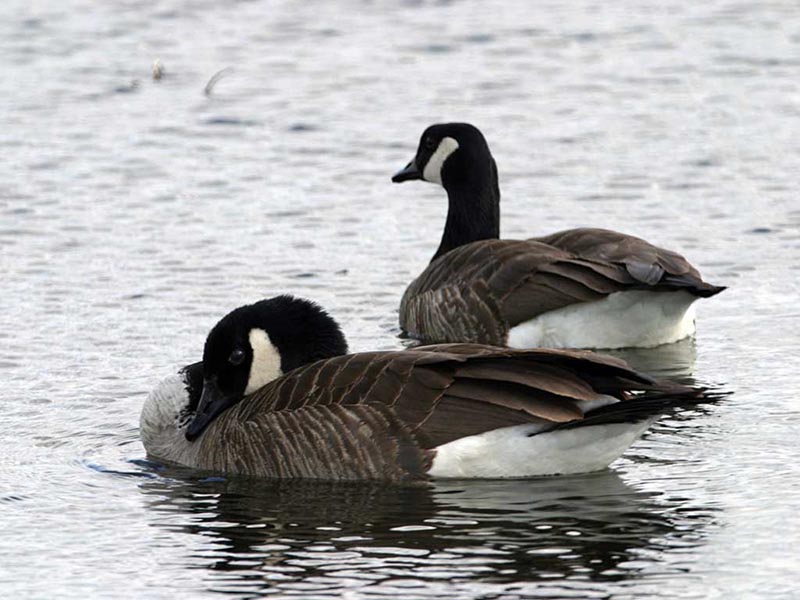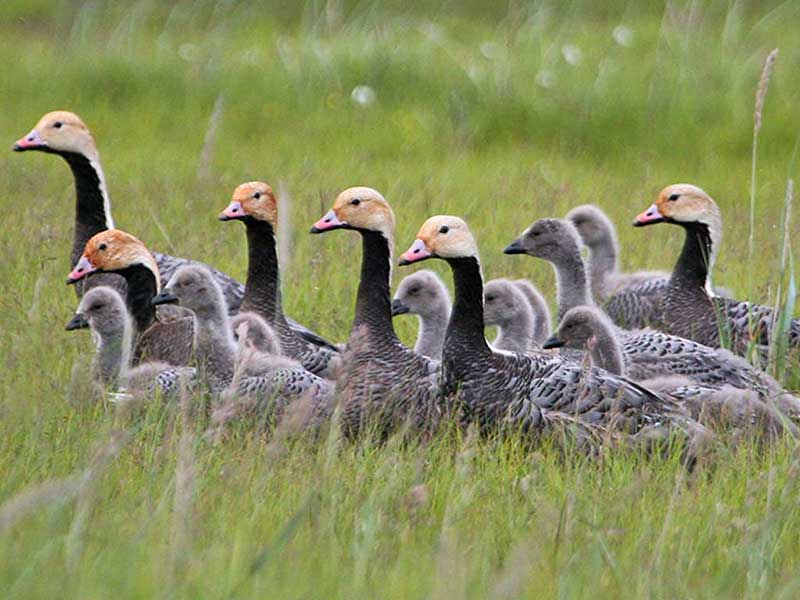
Geese are known for their v-shaped flight patterns and loud honks. These birds are often kept as pets due to their affectionate nature, high intelligence, and are highly susceptible to imprinting.
Female geese are called dames or simply geese. So are female geese identifiable? What are their lives like?
Let’s take a look at female geese and their role as mothers and partners.
On this page
Female vs Male Goose

Pair of White-fronted Geese. In this case, the female seems to be in the front.
Female and male geese are different in some ways, but not when it comes to their appearance. Most species of goose have females and males that look similar.
Read more: Do geese mate for life?
They are so similar, in fact, that it’s easy to get them confused.
Scientific Information
| Female Goose | Male Goose | |
| Size | Female geese tend to be smaller than male geese. A wild female goose can be anywhere from 5 to 12 pounds. Female domestic geese are anywhere from 12 to 16 pounds. | Male geese are usually larger than female geese. A wild male goose can be anywhere from 7 to 14 pounds. Male domestic geese are anywhere from 14 to 18 pounds. |
| Vocalizations | Female geese have high-pitched and quick voices. The vocalizations they make sound like “ka-ronk” and “hink.” | Male geese have lower-pitched and slow voices. They produce the typical honk that most people associate with these birds. |
| Behavior | Female geese are very protective of their young and will choose a mate based on their display. Once a female chooses a mate, she will follow them around. | Male geese are very protective of their flock as well as their mate. They honk very loudly, have complicated courtship displays, and will bite and chase other males that they view as competition during the breeding season. |
| Reproduction | Female geese are the ones to create the nest for their eggs. Wild geese lay anywhere from 5 to 12 eggs, and domestic geese lay anywhere from 20 to 60 eggs. The female will incubate the eggs for about 30 days before they hatch. | After finding a mate and mating with her, the male goose will stand guard to protect his future young and his mate from any possible threats. |
Plumage
Most species of geese have males and females that look identical. For example, Canada Geese, both males and females, have brown backs, black necks, black heads, tan breasts, and white cheeks and chinstrap.
However, even though you can’t tell the difference via plumage, you can take a closer look at their size. It’s tricky to differentiate birds by size, but females have more slender necks and are smaller than males.
Vocalizations
Geese are incredibly vocal birds. However, even though both females and males are talkers, their voices are different, so you’re able to tell the gender of a goose by listening closely.
Males have lower-pitched, slow voices. They produce the typical honk that is commonly associated with these birds.

The females produce calls that are higher-pitched and quick. It sounds like they’re saying “ka-ronk” and “hink.” The dominant bird in a mated pair is the one that’s the most vocal.
This means the more vocal bird could be male or female.
Behavior
Geese are monogamous birds that mate with a single partner for life. Courtship displays tend to be elaborate and courting behavior involves male and female birds dipping their necks toward each other. This usually takes place in the water when birds are swimming and begin to face each other.
Related: What do geese symbolize?
Female geese choose a mate by judging their displays and how well she thinks he will protect her. A female goose will follow a male she picked as her mate and stand next to him wherever he goes.
You may see male geese honking loudly while chasing and biting each other. They do this because they’re fighting over mates and are defending the ones who have already picked them. Mated pairs greet each other after being separated by loud honking.
Male geese are more aggressive than females because they’re the ones who take on the role of being the protector. They’re the guardians of both their flocks and mates. They’ll protect with confident body postures and harsh hissing.
However, female geese can also display aggressive behaviors when protecting their eggs, young, or nest from possible predators.
How To Tell A Younger Geese’s Gender?
There are a few different ways you can tell a younger geese’s gender.
First, you can look at the birds’ posture. Male geese, as young as 3 weeks old, tend to point their beaks up, hold their heads high, and stretch their bodies into a more vertical position. They do this to show dominance over females. Conversely, female goslings usually have a more horizontal posture and gracefully arched necks.

Group of Emperor Geese with their young.
Additionally, male goslings tend to vocalize in high-pitched, loud tones and grow faster than females do. Conversely, females have quieter, more low-pitched calls.
Related: What do geese eat?
Lastly, you can look at the color of their plumage. Some goose species, like the west-of-England, Shetland, and Pilgrim, are naturally sex-linked, which allows you to tell females from males by the time they reach 2 weeks old. Females will start to sprout gray feathers, while males’ feathers come in white.
Lifecycle
Geese build all of their nests on the ground. They’re usually near water, on an elevated site like a muskrat mound. Geese prefer spots that allow them to have a relatively unobstructed view in all directions.
Female birds pick the site and do most of the nest building. After the second egg is laid, the female will add body and down feathers.
Then, she does all of the incubating while the male guards both her and the nest. Nests are large open cups made of dry lichens, mosses, grasses, and other plant material.
The average goose lives to be anywhere from 10 to 24 years old. Both parents, especially the male, will strongly defend the baby geese until they fledge and are able to fly.
Baby geese fledge around 10 weeks after hatching. The juvenile geese will stay with their family for 1 year.
Keep reading: How long do geese live?
Female Goose – Frequently Asked Questions
What is a female goose called?
Female geese are called dames or geese.
Is female a gander?
No, female geese are not ganders. Gander is a term reserved for male geese.
Conclusions
Even though female and male geese look identical, they have other distinctive differences.
Males are larger, more vocal, and are more aggressive towards other birds. Females are smaller, build nests for their eggs, and aren’t as aggressive toward other birds.
However, it is tough to determine the gender of juvenile geese, and in the case of wild geese, the only ethical way to find it out is to observe their behavior.

